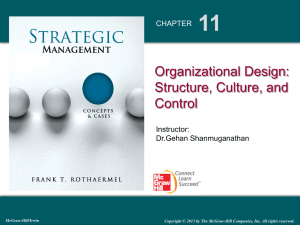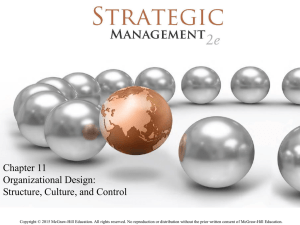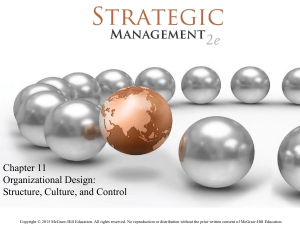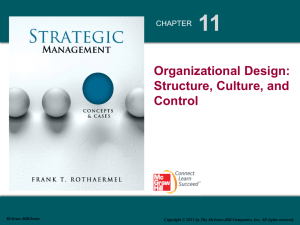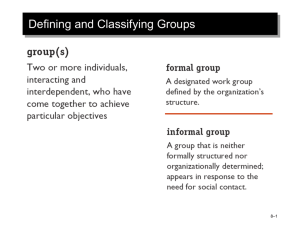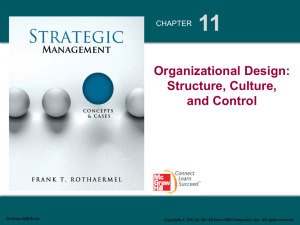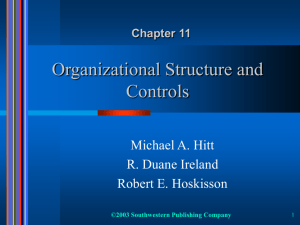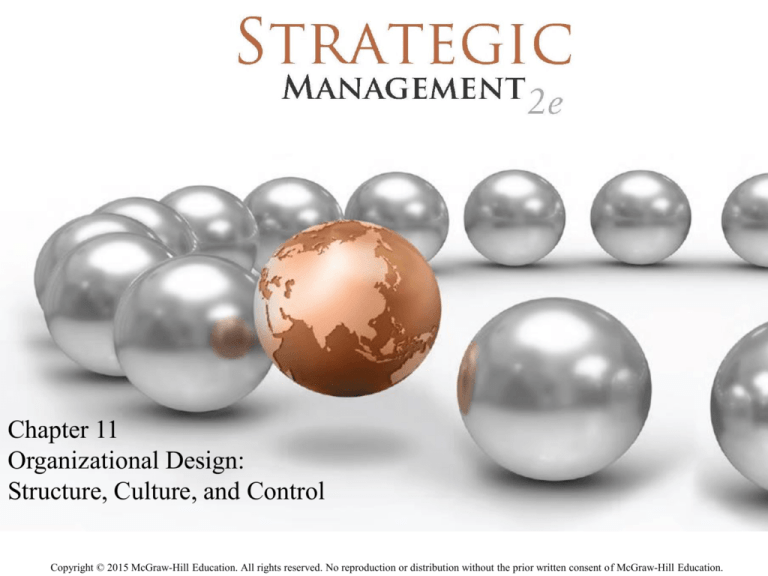
Chapter 11
Organizational Design:
Structure, Culture, and Control
Copyright © 2015 McGraw-Hill Education. All rights reserved. No reproduction or distribution without the prior written consent of McGraw-Hill Education.
11-2
STRUCTURE
CULTURE
CONTROL
• Determines how the
work efforts of
individuals and teams
are orchestrated and
how resources are
distributed
• Collectively shared
values and norms of an
organization’s
members; a key
building block of
organizational design
• Internal governance
mechanisms to align
the incentives of
principals
(shareholders) and
agents (employees)
11-3
11.1 How to Organize for
Competitive Advantage
Organizational design
• Goal is to translate strategies into realized ones
• Structure, processes, and procedures
Implementation… the “graveyard of strategy”
• Yahoo’s founder Jerry Yang was fired.
poor implementation….. lost 75% of market value
Structure follows strategies. (Alfred Chandler)
• Therefore structure must be flexible.
11-4
Exhibit 11.2
Organizational Inertia and the
Failure of Established Firms When External or
Internal Environments Shift
11-5
The Key Elements of
Organizational Structure
Organizational structure:
• Defines how jobs and tasks are divided and integrated
• Delineates the reporting relationships up and down the
hierarchy
• Defines formal communication channels
• Prescribes how individuals and teams coordinate their work
efforts
The key building blocks of structure are:
specialization, formalization, centralization, and
hierarchy.
11-6
The Key Elements of
Organizational Structure (cont’d)
Specialization: degree to which a task is divided
• Division of labor
Example: an accountant…
Large firm may specialize (e.g., internal audit)
Small firm may have an accountant be more of a generalist and take
on different roles
Formalization: codified rules and formal procedures
• Detailed written rules and policies
Examples: McDonald’s – 3 key priorities from the CEO
Airline pilots have a high degree of formalization.
Helps ensure safety and reliability
11-7
The Key Elements of
Organizational Structure (cont’d)
Centralization: where the decision is made
• Centralized decision making
Slow response time and reduced customer satisfaction
Example: BP’s Gulf Oil spill
• Centralization – top-down strategic planning (see Ch. 2)
• Decentralization – planned emergence (see Ch. 2)
Hierarchy: formal, position-based reporting lines
• Tall structure vs. flat structure
Tall structure-higher degree of centralization
Flat structure-lower degree of centralization
• Span of control − number of direct reports to a manager
11-8
Assembling the Pieces: Mechanistic
vs. Organic Organizations
Organic organizations
•
•
•
•
Low degree of specialization and formalization
Flat structure
Decentralized decision making
Uses virtual teams due to information technology
Examples: Zappos and W. L. Gore
Mechanistic organizations
• High degree of specialization and formalization
• Tall hierarchy
• Centralized decision making
Example: McDonald’s−Hamburger U in Chicago & China
11-9
11.2 Matching Strategy and
Structure
Simple Structure
Functional Structure
Multidivisional Structure
Matrix Structure
11-10
Simple Structure
Small firms with low complexity
Founders make all important strategic decisions
Low degree of formalization and specialization
A basic organizational structure
• Examples: Facebook in 2004 and small professional service
firms
11-11
Exhibit 11.4
Changing Organizational
Structures and Increasing Complexity as Firms Grow
11-12
Functional Structure
Groups of employees with distinct functional areas
The areas of expertise correspond to distinct stages in
the company’s value chain activities.
• Examples: College of Business Administration, strong CEO
organizations
Recommended with limited diversification
• Matches well with business-level strategy
Cost leadership
Mechanistic organization
Differentiation
Organic organization
Integration strategy
Ambidextrous organization
11-13
Exhibit 11.5 Typical Functional
Structure
11-14
Exhibit 11.6 Matching BusinessLevel Strategy and Structure
11-15
Strategy Highlight 11.2
USA Today: Leveraging Ambidextrous Organizational Design
USA Today: one of the biggest print circulations in U.S.
Used an ambidextrous organizational design to
successfully reintegrate its independent online unit
USA Today.com created as an in-house startup
• Has large cultural differences and is separated from the print
biz
• Starved for corporate resources despite initial success
USA Today and USA Today.com then integrated,
• Leveraging synergies and changing senior team incentives.
• General managers key to finding synergies.
11-16
FUNCTIONAL STRUCTURE: DRAWBACKS
Facilitates rich and extensive communication between
members of the same department
• It frequently lacks effective communication channels
across departments.
A firm can set up cross-functional teams to improve this problem.
With growth, cannot effectively address a higher level
of diversification
11-17
Multidivisional Structure
Consists of several distinct SBUs
Each SBU is independent and led by a CEO.
Each CEO of SBU reports to the corporate office.
• Examples:
Zappos is an SBU under Amazon.
W. L. Gore has four product divisions.
Companies using M-form structure
• GE, Honda
M-form is a widely adopted organizational structure,
as most large firms are diversified to some extent.
11-18
Exhibit 11.7 Typical Multidivisional
(M-Form) Structure
(Note that SBU 2 uses a functional structure and SBU
4 uses a matrix structure.)
11-19
Multidivisional Structure
(cont’d)
Use with various corporate strategies
Related diversification
• Co-opetition among SBUs
• Transfer core competences across SBUs
• Centralized decision making
Unrelated diversification
• Decentralized decision making
• Competing for resources
11-20
Exhibit 11.8 Matching CorporateLevel Strategy and Structure
11-21
Matrix Structure
A combination of functional and M-form structure
•
•
•
•
Creation of dual line of authority and reporting lines
Each SBU receives support both horizontally and vertically
Very versatile
Enhanced learning from different SBUs
Shortcomings
• Difficult to implement
• Complexity increases when expanding, especially globally
• Unclear reporting structure causes confusion and delays
11-22
Exhibit 11.9 Typical Matrix Structure
with Geographic and SBU Divisions
11-23
NETWORK STRUCTURE
Growing with computerized collaboration tools
Benefits from communities of practice
Learning and knowledge management
Need corporate support in terms of procedures and
policies
11-24
Exhibit 11.10 Matching Global
Strategy and Structure
11-25
STRUCTURE
CULTURE
CONTROL
• Determines how the
work efforts of
individuals and teams
are orchestrated and
how resources are
distributed
• Collectively shared
values and norms of an
organization’s
members; a key
building block of
organizational design
• Internal governance
mechanisms to align
the incentives of
principals
(shareholders) and
agents (employees)
11-26
11.3 Organizational Culture:
Values, Norms, and Artifacts
Organizational culture
•
•
•
•
Collectively shared values and norms
Value: what is considered important
Norms: appropriate employee behaviors and attitudes
Artifacts: expression of culture in items such as physical
design, stories, and celebrations
Socialization
• Internalize organization’s value and norms through
interactions
Think of Zappos’ core values
11-27
Exhibit 11.11 The Elements of
Organizational Culture:
Values, Norms, and Artifacts
11-28
Where Do Organizational
Cultures Come From?
Founder imprinting
• Founders defined and shaped the culture
Apple (Steve Jobs)
Microsoft (Bill Gates)
Harpo Productions (Oprah Winfrey)
Walmart’s “low cost” culture by Sam Walton
Recruit people that fit the culture
• Zappos pays new hires if they want to…. quit!
11-29
How Does Organizational
Culture Change?
Culture can be a strong asset, yet also a great liability
Core competency core rigidity
• Culture no longer has good fit with the environment
• Cultural change is needed
Cultural change
• Brings new leadership
• Mergers and acquisitions
11-30
Organizational Culture and
Competitive Advantage
Culture must be valuable, rare, inimitable, and nonsubstitutable (VRIO see Ch. 4)
• Protected by causal ambiguity and social complexity
Culture affects behavior and firm performance:
• Southwest Airlines (SWA)
SWA’s unique culture helps it keep costs low by turning around its
planes faster, thus keeping them flying longer hours
• Zappos
Zappos’ “WOW” customer experience is accomplished by “going
the extra mile.” Long-term superior experience does increase the
company’s perceived value and its economic value creation.
11-31
STRUCTURE
CULTURE
• Determines how the
work efforts of
individuals and teams
are orchestrated and
how resources are
distributed
• Collectively shared
values and norms of an
organization’s
members; a key
building block of
organizational design
STRATEGIC
CONTROL &
REWARD
SYSTEMS
• Internal governance
mechanisms to align
the incentives of
principals
(shareholders) and
agents (employees)
11-32
11.4 Strategic Control and Reward
Systems
Internal governance mechanisms
• Culture
• Sanctions
Input controls
• Budgets
• Rules and standard operating procedures
Output controls
• Result-oriented
• ROWEs −3M; 15% work on own projects
Not directed from the top
11-33
11.5 Implications for the Strategist
Formulating effective strategies
• Necessary but not sufficient condition
To gain and sustain competitive advantage
Strategy execution is at least as important for success.
•
SWOT helps operationalize strategy implementation.
Strategy implementation requires managers to design
and shape structure, culture, and control mechanisms.
Strategy formulation and implementation
• Iterative and interdependent activities
11-34
Exhibit 11.12 Strategy Implementation:
Turning a SWOT Analysis into Action
11-35

